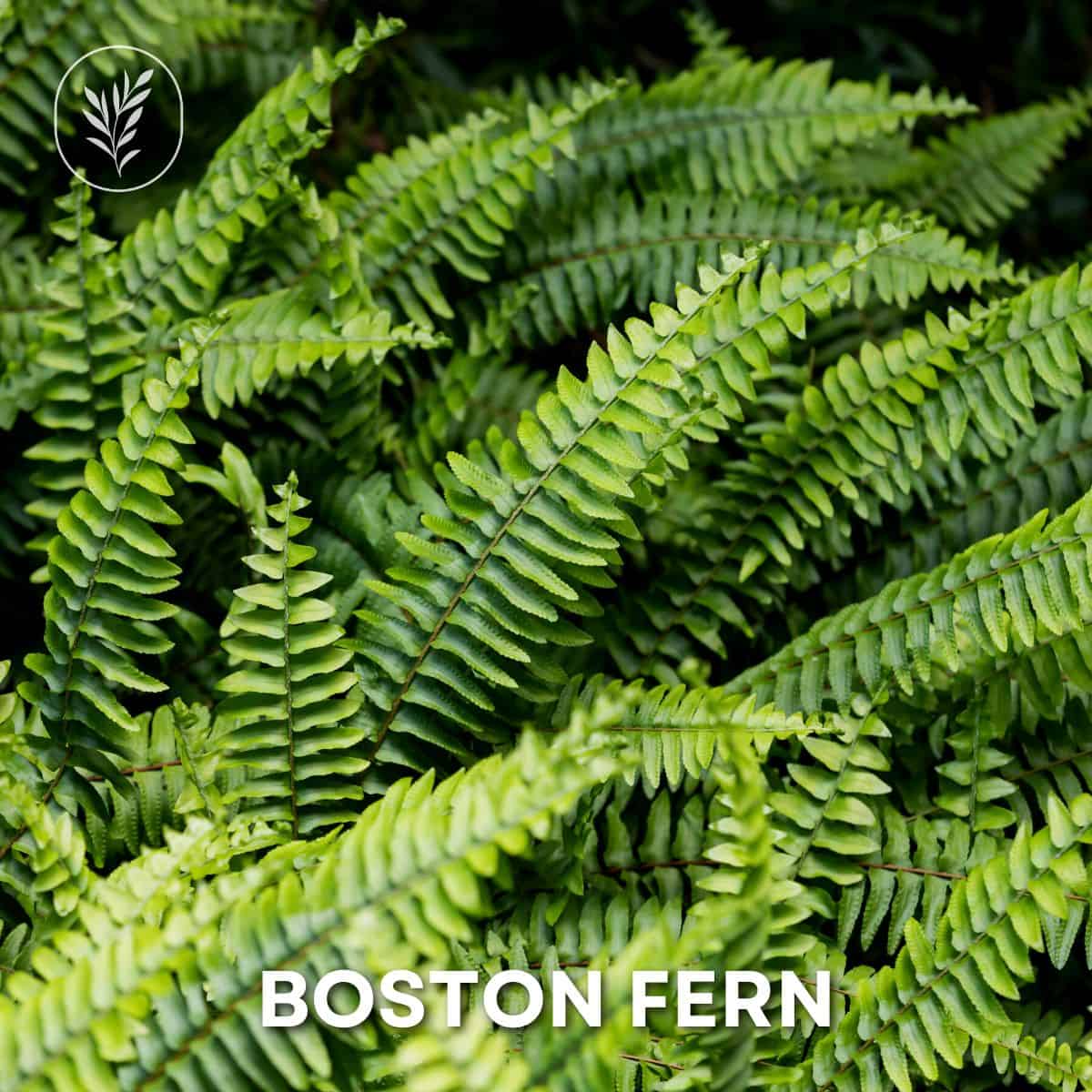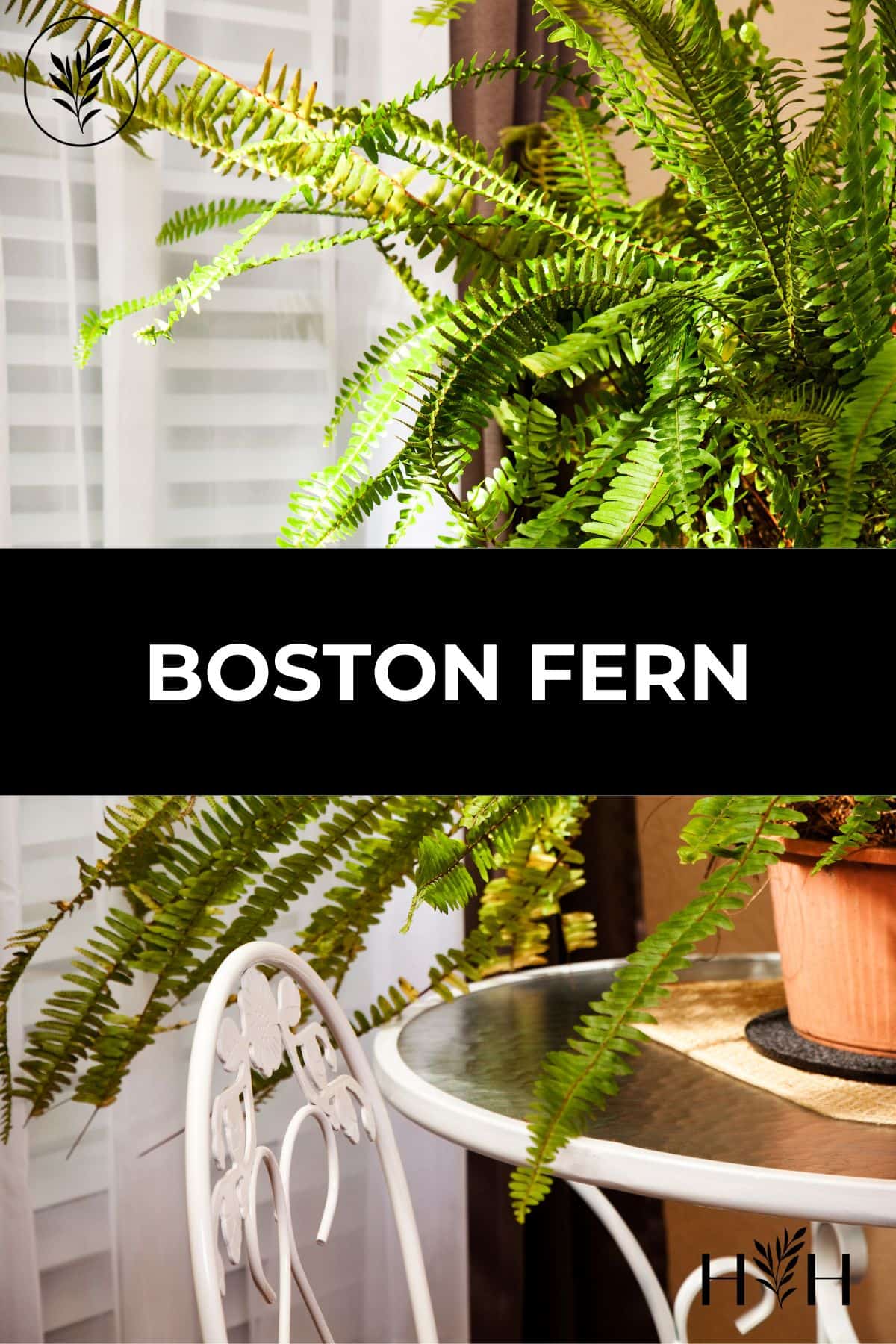Boston Fern is a tropical evergreen perennial herbaceous plant grown as the classic indoor houseplant fern. Boston Fern (Nephrolepis exaltation “Bostoniensis”) can be lush, graceful, and add a touch of woodsy whimsy to your home. They thrive with constant moisture and can put up with the lower-light conditions of indoor environments. Let’s look in detail at Boston Fern and how to care for this lovely houseplant.
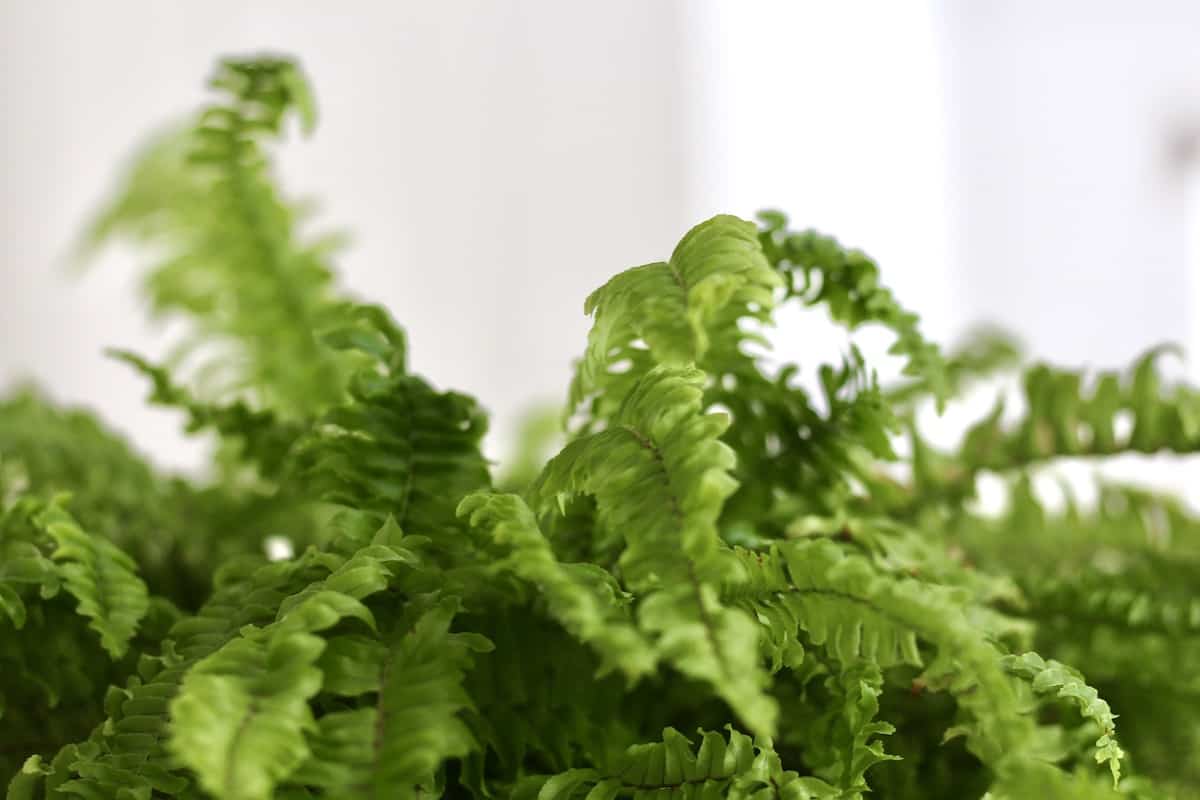
An introduction to Boston ferns
Boston ferns have skinny green fronds that dangle away from the center of the plant. Most indoor Boston Ferns are 2-3 feet (60-90 cm) tall and wide. They love moist soil and dappled shade.
“This is a lush, graceful fern, with long, arching fronds that makes a lovely specimen plant on a pedestal or in a hanging basket. In the right conditions, the fronds can reach 48-in. (120 cm) long, and are a rich mid-green with numerous pinnae occurring alternately on each side of the midrib. As the plant matures, 2 rows of brown sporangia become apparent on the underside of each pinna, on either side of the central vein.”
The Complete Guide to Houseplants: The Easy Way to Choose and Grow Happy, Healthy Houseplants, by Valerie Bradley
The Boston Fern is a natural mutation of a native tropical fern. While most ferns of the species have upright fronds, one particular plant had drooping leaves instead. The unique plant specimen was picked out and propagated as a houseplant.
As one would expect, Boston Ferns do have a connection to the city of Boston:
“All plants in cultivation are natural mutations of the species. The original mutant, ‘Bostoniesis’, was discovered in 1894 in a shipment of ferns sent to Boston by a Philadelphia grower. In contrast to the species, which has upright fronds, its fronds dangled down and away from the central crown.”
What’s Wrong With My Houseplant?: Save Your Indoor Plants With 100% Organic Solutions, by David Deardorff and Kathryn Wadsworth
Where to buy Boston fern plants
Boston fern plants can be purchased online, at a local floral shop, or at a garden center.
“This fern can add a feeling of lushness to any room, particularly if you hang it in a basket or place it on a pedestal so that its long fronds can dangle.”
How to Houseplant: A Beginner’s Guide to Making and Keeping Plant Friends, by Heather Rodino
Basic Boston fern care
The basics of Boston fern care are as follows:
- Keep the soil moist all of the time
- Place the plant where leaves get some light, but avoid direct sunlight
- Feed the fern with a quality water-soluble organic houseplant fertilizer
- Repot the plant in spring or summer every year or two
Boston ferns in the wild
The native habitat of Boston Ferns is a tropical rainforest climate. Ferns in general are herbaceous perennials that tend to grow in the understory of forests or other areas with dappled shade. Boston Ferns are adapted to tropical temperatures and will not survive cold winters outdoors in temperate zones.
“In nature, ferns grow as part of the understory or attach themselves to bark or trees, depending on the species. This means most are used to dappled light and partial shad, making them great choices for low-light environments.”
The Inspired House Plant: Transform Your Home With Indoor Plants from Kokedama to Terrariums and Water Gardens to Edibles, by Jen Stearns
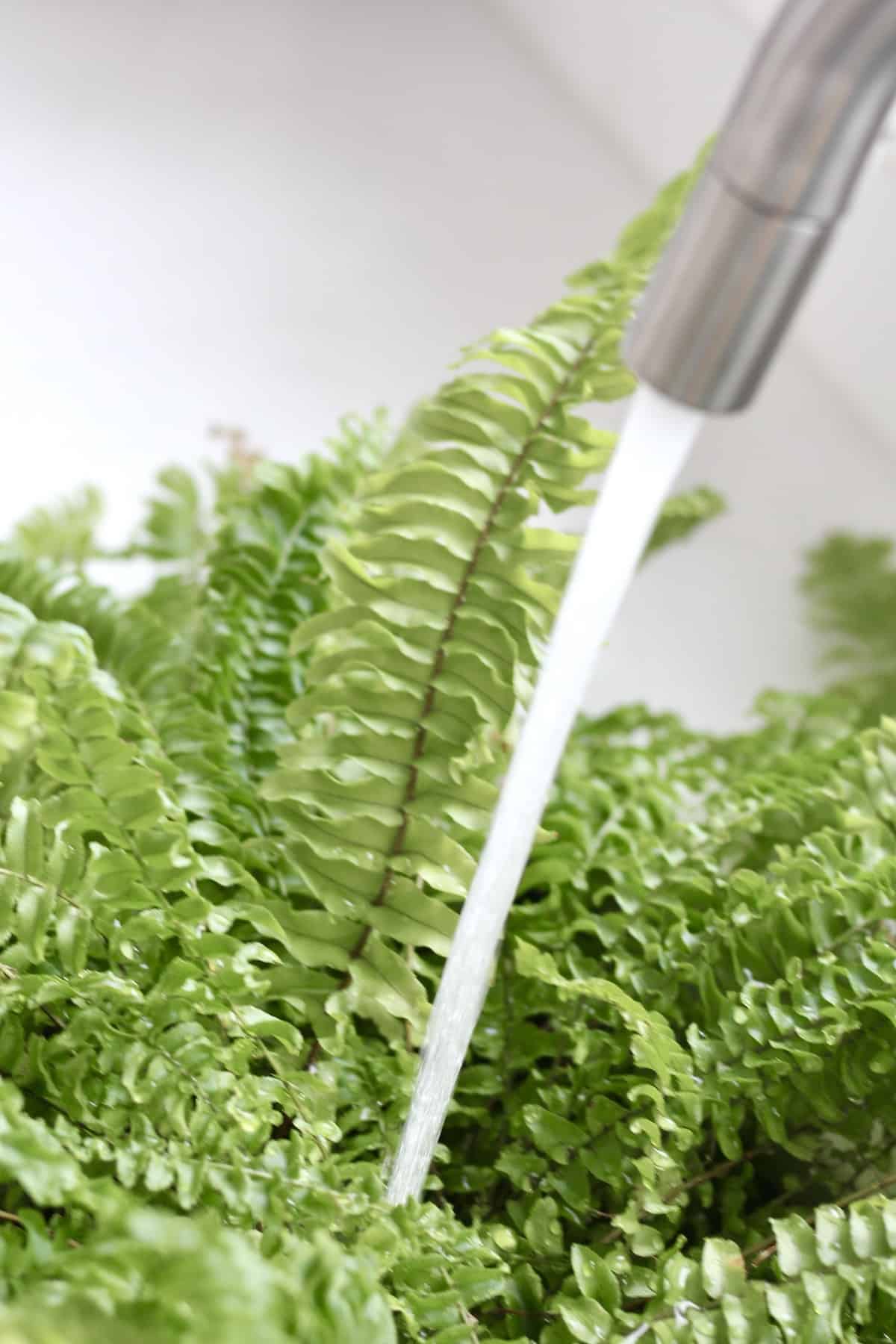
How often to water Boston fern
Boston fern should be kept in consistently moist soil. These ferns are a classic example of “keep the soil wet, but not too wet”. Could anything be more confusing?
Fortunately, Boston Ferns will put up with overwatering more than most houseplants will. Along with the lovely flowering Anthurium, the Boston Fern is a plant that can be watered daily if you so choose without ill effect, as long as the plant is potted in very well-draining soil. Lots of water can go in as long as it quickly can go out too!
“Keep the soil mix thoroughly moist at all times. In higher temperatures, dry air will cause browning of the pinnae, so be sure to increase humidity by standing the pot on a tray of moist pebbles. Water with standard liquid fertilizer every 2 weeks from spring to autumn.”
The Complete Guide to Houseplants: The Easy Way to Choose and Grow Happy, Healthy Houseplants, by Valerie Bradley
“Keep the soil consistently moist but not soggy, watering when the surface of the soil feels dry. Do not let it dry out; it may drop leaves. Mist regularly or use a pebble tray to satisfy this plant’s love of humidity. A bathroom with good light is an excellent spot for a Boston fern.”
How to Houseplant: A Beginner’s Guide to Making and Keeping Plant Friends, by Heather Rodino
Humidity for Boston ferns
Boston ferns love humid air! These are tropical rainforest plants after all. Some houses have built-in whole-home humidifiers in the HVAC system. Other homes in dry areas may have to use a freestanding humidifier to keep the air humid. Maintaining an indoor humidity of 40 is a fairly common target for those in dry areas who like to humidify the air for their houseplants, musical instruments, or their own comfort.
There are certainly more simple ways to provide a humid environment in the neighborhood of your Boston Fern. These houseplants do like to be misted with water and can even enjoy a light shower in the kitchen sink. Keeping the plant resting on a tray of water and pebbles is also quite a common practice.
“At home in moist temperate or tropical rain forests and woodlands, ferns love humidity. Keep the soil around your fern moist to the touch, watering anywhere from daily to every couple of days. Once a week, give your fern a good misting and it will love you back! If the heat or air conditioning is often running in your home, take care to compensate for that drier air by paying ore attention to your fern and watering more frequently.”
The Inspired House Plant: Transform Your Home With Indoor Plants from Kokedama to Terrariums and Water Gardens to Edibles, by Jen Stearns
“Mist your plant twice a week with a spray bottle of water on a mist setting, or use a handheld mister. Put the pot in a saucer or tray of water, making sure the bottom of the pot never sits directly in the water by raising the pot up on pot feet or pebbles. Or put a humidifier in the room.”
What’s Wrong With My Houseplant?: Save Your Indoor Plants With 100% Organic Solutions, by David Deardorff and Kathryn Wadsworth
Fertilizer for Boston ferns
Boston Ferns do need to be fed with a quality organic houseplant fertilizer. I like to use water-soluble fertilizers that can just be added to the watering routine. Some houseplant parents prefer the granular fertilizer types that are sprinkled onto the top of the soil surface. Either way, your Boston Fern does need to be fed, as it’s not getting soil nutrients otherwise refreshed by its surroundings.
“Use any organic fertilizer, in either a powder or liquid formulation, where the first number (nitrogen) is higher than the other two. Apply at half-strength once a month through the growing season.”
What’s Wrong With My Houseplant?: Save Your Indoor Plants With 100% Organic Solutions, by David Deardorff and Kathryn Wadsworth
Sunlight requirements for Boston ferns
Boston ferns are one of the more shade-tolerant plants commonly grown indoors. Most houseplants have become “houseplants” because they can put up with the less-than-bright conditions inside our homes. Understory forest plants in warm environments – like herbaceous perennials from tropical rainforests – tend to fit this description well. Boston Fern is quite at home in our homes!
Do remember though that for a plant, sunlight equals food. All plants need sunlight – even plants that are adapted to live in dappled shade. Your Boston Fern does need some sunlight – just try for indirect light rather than putting it in the direct beam of the sun.
“Medium indirect light is best, such as that from an eastern window. If the light is filtered through a sheer curtain, you can also place a fern near a southern or western window.”
How to Houseplant: A Beginner’s Guide to Making and Keeping Plant Friends, by Heather Rodino
How to trim a Boston fern
Boston fern plants do need to be trimmed now and then. These plants grow naturally in a lovely shape and don’t need to be pruned for shape at all. Most of the trimming of a Boston Fern is simply removing the least-healthy foliage. In general, any foliage that is dead, diseased, or damaged should be removed right away. Trim off any brown or badly-yellowed leaves and keep an eye out for baby plantlets emerging from shoots off the base of the crown.
“Even with regular misting, some plants will occasionally develop brown tips, there is no chance they will recover and green up, so go over the plant occasionally and snip them off. The plant will look better for it.”
My Tiny Indoor Garden: Houseplant Heroes and Terrific Terrariums in Small Spaces, by Lia Leendertz
“If the lower fronds are faded or brown, give the plant a little haircut and trim them off.”
How to Houseplant: A Beginner’s Guide to Making and Keeping Plant Friends, by Heather Rodino

How to propagate Boston fern
Boston fern plants are generally propagated by dividing an existing plant up into multiple plants. This can really be done any time of year, but it is most often done in the spring or during summer repotting.
So, how do you divide a Boston Fern? Here is how to propagate a Boston Fern by dividing it:
- Pull the fern out of its pot
- Trim off any leaves/fronds that are dead/diseased/damaged
- Gather up the fronds and pull them away from the base
- Gently brush away any leaf bits or other debris on the surface
- Look for tiny new plantlets growing away from the main crown
- Use a sharp, clean knife to separate the plantlets from the mother
- Place each fern plantlet in its own pot with potting mix and water it
- The main crown can be divided (often into 4 pieces) with a sharp knife
- Place each root division in its own pot with potting mix and water it
“Making more plants: Furry runners grow from the rhizome, and plantlets develop at their tips. Remove the plantlet once it has rooted by severing the runner with a sharp knife. Spore propagation is not easy, because viability is variable.”
The Complete Guide to Houseplants: The Easy Way to Choose and Grow Happy, Healthy Houseplants, by Valerie Bradley
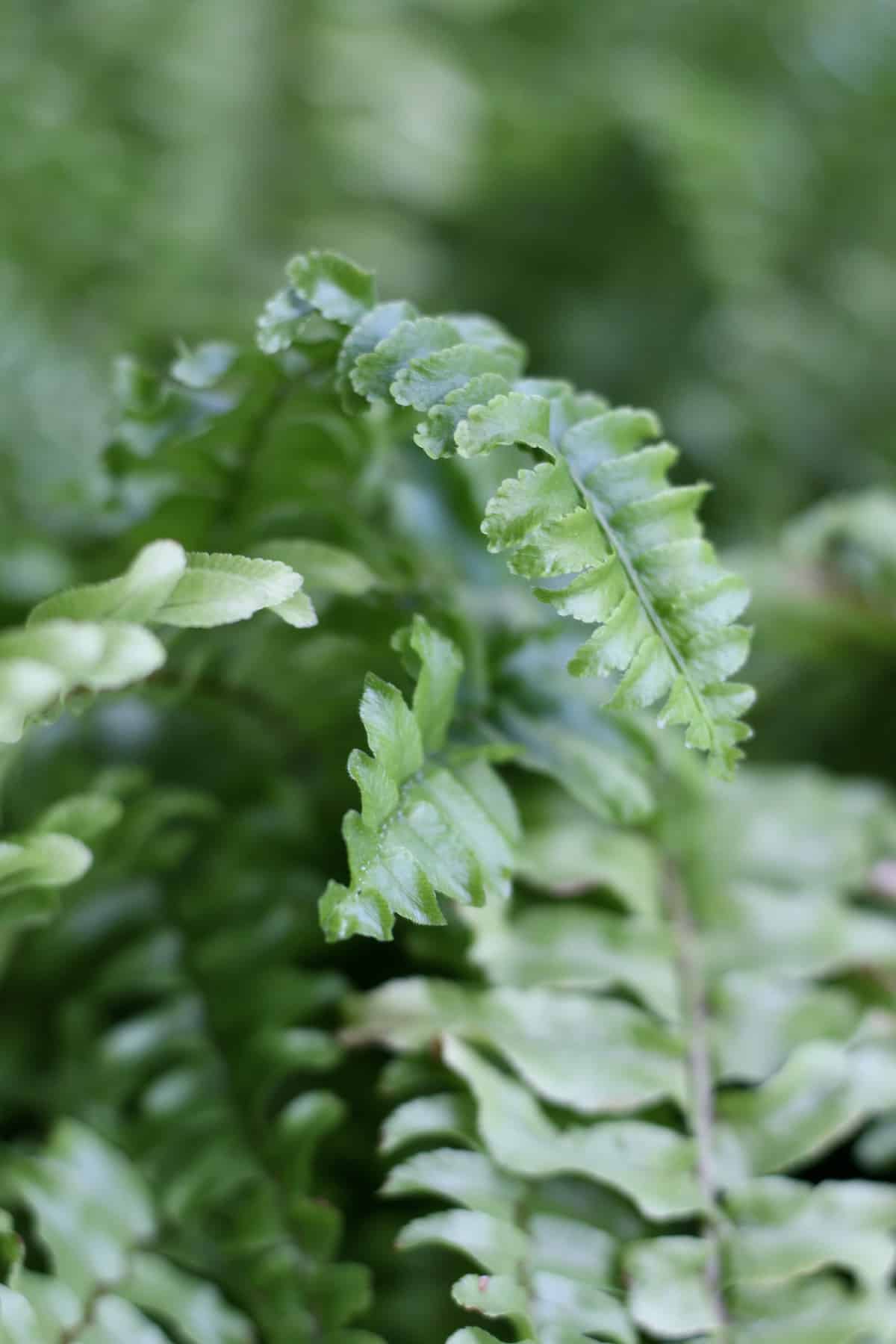
How to re-pot a Boston fern
Boston ferns are generally repotted every 2-3 years. Small ferns may have to be up-potted into 2″ larger pots annually for a few years while they grow to their full mature size. Big ferns are generally ok in the same pot for many years as long as the plantlets are removed and the soil is refreshed.
“Use any good organic, well-drained, general-purpose potting soil that incorporates organic fertilizer, mycorrhizal fungi, and other beneficial microbes.”
What’s Wrong With My Houseplant?: Save Your Indoor Plants With 100% Organic Solutions, by David Deardorff and Kathryn Wadsworth
Use a high-quality organic potting mix that’s designed to hold both water and air for the fern’s roots to access. The surface of the soil of a Boston Fern houseplant can be left bare in the pot, but does tend to look lovely with a surface mulch of live moss to help keep the soil moist.
“Friends out in the wild, mosses and ferns make excellent companion plants in terrariums and bowls, each playing up the form of the other and needing similar care and feeding.”
The Inspired House Plant: Transform Your Home With Indoor Plants from Kokedama to Terrariums and Water Gardens to Edibles, by Jen Stearns
Resources
- My Favorite Tools For Caring For Houseplants
- Houseplant Propagation Guides
- Follow My Houseplant Board on Pinterest


